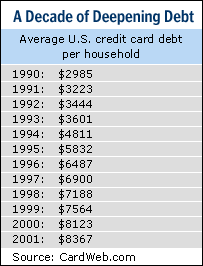
NEW YORK (CNN/Money) -
Late payments on credit card bills hit a five-year high in March while write-offs by banks for uncollectable debt reached an 11-year high, according to a published report Monday.
Credit card debt more than 30 days past due hit 5.54 percent in March, up from 4.93 percent a year earlier and the highest level since June 1997, USA Today reported, citing data from research firm CardWeb.com.
As card users delayed paying off balances, the amount of debt written off by creditors as uncollectable reached 6.59 percent in March, up from 4.74 percent last year and the highest since February 1991, the report said.
Most of the bad credit card debt comes from poorer credit card holders, many of whom were unable to refinance homes or otherwise take advantage of low interest rates in 2001, according to the report. Lower minimum payments and higher penalty payments also are stretching out debt, the report said.

Many of these same poorer consumers have in recent years been the target of aggressive marketing campaigns that recruited new customers regardless of their credit history.
"The poor are targeted, and many of them don't understand credit," said Joy Franklin, head of operations at the American Credit Alliance, a debt-counseling agency. "Financial literacy is so poor in this country; nobody pays attention to these things."
"Maybe banks could do something by, in their statements, giving tips on how to improve credit," she added. "It would be good for the banks and good for the nation."
But credit-card companies are generally profitable enterprises, even those that lend to high-risk customers. And many credit counselors say people have to take responsibility for their own debt.
| |
 Related stories
Related stories
| |
| | |
| | |
|
"You can chastise [high-risk lenders], but you could also say that some people deserve a second chance and would have no other access to credit without them," said Steve Rhode, co-founder of credit counseling firm Myvesta. "At some point, there has to be some level of common sense."
For example, Rhode noted that many of his clients admit to filling out every card application they get in the mail without stopping to think if another card would be necessary -- or affordable.
"Just because somebody will approve you, that doesn't mean you can afford it," Rhode said.
Consumer spending is critical to the U.S. economy, making up about two-thirds of the nation's gross domestic product (GDP). Strong spending, driven by aggressive retailer incentives such as zero-percent financing on auto loans, helped make the latest economic recession among the shortest and mildest in history.
Some economists have warned that high levels of consumer debt could force consumers eventually to regroup, cutting back on spending in order to fix their balance sheets.
But the impact of debt is debatable; though the average household credit card debt skyrocketed to $8,367 in 2001 from $2,985 in 1990, according to CardWeb.com data. The U.S. economy also enjoyed its longest expansion in history during that time.
"I don't think [credit card debt] is a problem. It won't stop the expansion," said Delos Smith, economist and senior business analyst at the Conference Board, a research group that publishes a closely watched monthly survey of consumer confidence. "It's something we need to look at, but I consider the American people very prosperous."
| |
 Related links
Related links
| |
| | |
| | |
|
The Federal Reserve recently said revolving consumer credit, most of which is credit card debt, grew just 1.2 percent in February, the latest data available, compared with a red-hot growth rate of 11.5 percent in 2000 and slower even than the 3.9 percent growth in 2001.
Some lenders have begun to review their aggressive marketing campaigns, accounting for part of that decline, and many wealthier consumers were able to use lower interest rates, driven down by 11 Fed rate cuts in 2001, to more easily pay off debt.

|

